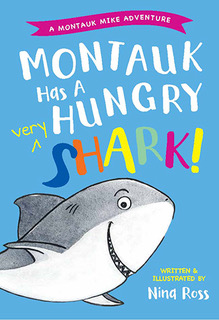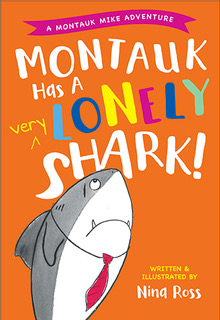A Sundae-Loving Shark


It’s been 45 years since “Jaws” exploded on the screen, terrifying beach goers. Aided by John Williams’s propulsive score that signaled the ominous arrival of a man-eating great white on Long Island, the movie for sure gave that big fish a bad rep. Of course, sharks didn’t need Benchley’s book or Spielberg’s film to conjure up a ferocious image for themselves. The word “shark” (origin uncertain) had other unpleasant associations early on, having to do with fraud or trickery.
It’s surprising, therefore – and admirable — to see what artist and writer Nina Ross imagined about a shark in her charming and lovely-to-look-at story books for young children “Montauk Has a Very Hungry Shark” (2019) and its just published sequel “Montauk Has A Very Lonely Shark.” Moby Dick, move over, Montauk Mike is on the move, and he doesn’t have a monomaniacal ship captain out to get him. In fact, poor Mike, as he’s known by the locals in town, really has no one out to get him — as food or for friendship. Ross, visual artist, creative writer and Master of Arts in Arts Education to the rescue.
Parents, grandparents, caregivers, older sibs — not to worry. Mike in the first book is hungry, all right, but not for people. He craves sweets, particularly sundaes and especially a caramel and fudge one, with whipped cream and a cherry on top. In fact, he likes a lot that people like and has zero interest in terrifying anyone or even chasing other fish. To reinforce Mike’s “unusual” and lovable aspects, Ross, who knows that less is more, leaves him on a page with a lot of white space and focuses on his smile and sartorial aspect. He favors wearing a tie. Watercolors, for sure, are her medium, and Ross has a keen sense for using minimalist lines that contour Mike, and soft pastel hues for landscapes that show the towns Mike travels through on his quest for the perfect sundae in book one.

What distinguishes both books is Ross’s sly gentle nod to grownups. As Mike tries to find his perfect sundae, he looks for a taxi. But, of course, you can’t get a cab anywhere! He gets a bike. Still, people are nervous about hanging out with him. Even the swans in East Hampton Town Pond make it clear he’s not welcome, even though he’s wearing swim trunks. Not with that fin! Ross neatly depicts regional romps. Readers will recognize villages and shops.
Without intending to, Mike puts off just about everyone except a little girl in a pink dress who tells him, after he goes into a tantrum out of frustration: “Here’s some advice, if you don’t mind?/To get what you want, always be kind!” Ross uses internal and external rhyme that avoids predictable sing-song meter. And puns. Tale one ends with the word “fin.”
Mike found his ideal sundae (in Sag Harbor) but, alas, is still lonely. In “Montauk Has A Very Lonely Shark,” he sits on a beach surrounded by cast off phones (built-in obsolescence on subtle display), wondering if anyone will call, hoping, of course, it would be the little girl in the pink dress. What fun they might have, riding the bike, flying a kite, having breakfast at night (syrupy cake for sure). Meanwhile, he inadvertently scares everyone. Except a sparrow, sitting on buoy, who talks to Mike and agrees to help him try to find the little girl in the pink dress.
They go to the North Fork, passing The Big Duck, and the sparrow advises Mike not to try to talk to it because it’s a house. They chat with sea gulls and other animals. Finally, Mike decides to splash himself into the sky to gain newspaper recognition and maybe thus attract the little girl. It works. She sees him on TV and dashes down to the beach to meet him. And lo! He has two friends now — her and the sparrow.
It’s not easy to be creative at such a challenging time and avoid sentimentality, didacticism or cliché, but Ross pulls off an original, delightful tale for little ones. With a wink to grown-ups.



